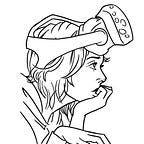What is an NFT, and did I just pay $100 for a JPEG?
What is it?
Non-Fungible Tokens (NFTs) are an exciting way to support artists and collect artwork. The general idea is that you are purchasing a contract between you and an artist. That contract says that you are a symbolic “owner” of a piece of artwork.
Rather than a receipt, this transaction between you and the artist is recorded in a blockchain (if you’re not familiar with blockchains, think of them as public ledgers). You can hold onto this contract, or sell it to another buyer. Just like traditional art collectors, NFT collectors may “invest” in an artist by buying up their work, and attempting to sell it at a profit.
During NFT transactions, it’s very possible that digital artwork is not actually ever being exchanged: It’s only the aforementioned contract between the current “owner” and the artist that is changing hands. It’s possible or even likely that the artist is already posting their digital artwork publicly, at no cost.
So why would anyone of sound mind and conservative wallet purchase an NFT? Well, you buy them because you like the art, and you want to support the artist. For the same reason you tip a live band, buy prints at Comic-Con, or pay to read Webtoons a week early.
How does it work?
Imagine a blockchain as a public ledger. Each entry in the ledger is a contract with a unique ID associated with it:
ID #1: Alice sells a portrait to Brianna for $50
ID #2: Caitlin sells a concert ticket to Devon for $30
ID #3: Elise sells a pizza to Fiona for $15In the example above, Fiona now owns the pizza she purchased from Elise, as per the terms of their contract. The contract is as simple as “I give you $15, and you give me a pizza”.
Creating an NFT is the act of adding a special type of contract to the ledger. This contract has no buyer specified:
ID #1: Alice sells a portrait to Brianna for $50
ID #2: Caitlin sells a concert ticket to Devon for $30
ID #3: Elise sells a pizza to Fiona for $15
ID #4: Grimes offers a piece of artwork with no buyer specifiedIn the example above, Grimes now owns “the contract on the blockchain with id #4”. This special kind of open-ended contract is called a Token. Since the blockchain (our ledger) is permanent in nature, we may refer to this as a non-fungible (unchanging) Token.
Let’s dive a bit deeper
Here is a JPEG from Grimes. How exactly does this get linked to an NFT?
The process she followed to create an NFT and associate it with the above artwork goes something like this:
- Sign up for an account on an NFT Marketplace. In this case, Nifty Gateway.
- Upload the artwork along with a bit of information about your work. In this case, it was the JPEG above, and the description “Newborn 3 By Grimes x Mac. Date: 01/07/2020. Resolution: 3000 x 3000”.
- Nifty Gateway will write a “contract” for you, and insert it into the Ethereum blockchain (the Ethereum currency’s ledger) as a Token. The contract specifies you as the owner of the NFT, and specifies no particular buyer.
- The contract is not written in plain English, instead it’s written in code. We call this a “Smart Contract”. You might think of it like a tiny program that executes each time the NFT is sold to a new owner.
- Here is an image-capture of Grimes’ Smart Contract, which lives as public information on the Ethereum blockchain:
- This tiny program can do many things, such as extract royalties from a sale and give kickbacks to the original artist, in perpetuity! But, more relevant to our conversation, this tiny program has several properties associated with it, one of which is an internet address pointing to information about the artwork. That information is hosted on the NFT Marketplace.
- That information lists your artwork description, as well as a link to the image you uploaded. Here is what the information of “Newborn 3” looks like:
{
"description": "Newborn 3 By Grimes x Mac. Date: 01/07/2020. Resolution: 3000 x 3000",
"background_color": "ffffff",
"external_url": "https://niftygateway.com/#/",
"image": "https://res.cloudinary.com/nifty-gateway/image/upload/v1614181985/Max/Grimes/Newborn_3_f8zgk5.jpg",
"name": "Newborn 3 #1/100"
}- It’s the responsibility of the NFT Marketplace you signed up with to maintain this information, as well as your uploaded JPEG, though nothing but self-interest is binding them to this agreement.
And that is how artwork becomes NFT Artwork!
What’s next?
We’ve now touched on what an NFT is, why you might want to buy one, and how they’re made. I hope this article has helped shed light on this latest craze.
It’s also my sincere hope that the popularity of NFT’s will draw attention to the environmental impact of cryptocurrency mining. I am optimistic about this, because the crypto-space is now enduring a sudden influx of artists. And if there’s anyone who can make a revolution irresistible, it’s us! 👩🎨🎨
Addendum: CG Garage invited me to speak on this topic a few days before writing this article. The vodcast is now out, here.
